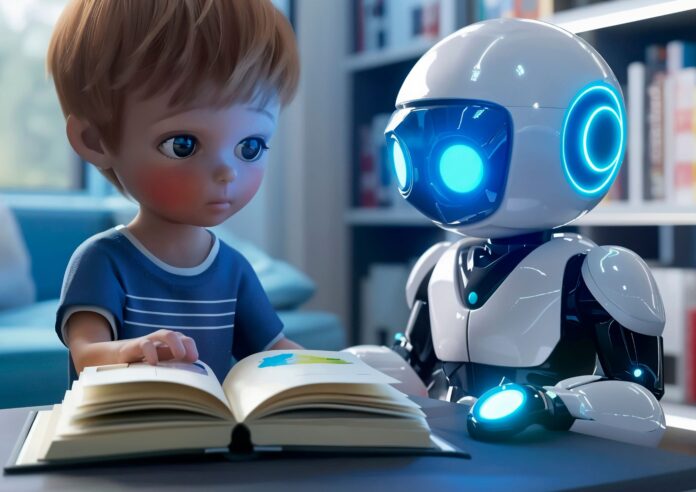Artificial Intelligence (AI) is revolutionizing nearly every industry, and education is no exception. In recent years, AI has emerged as a powerful tool, reshaping the ways in which teachers approach a child’s education and students engage in learning. From automating administrative tasks to creating personalized learning experiences, AI’s applications are as diverse as they are impactful.
This article explores how Artificial Intelligence is transforming teaching and learning, its benefits, and the challenges it presents, as well as the future of AI in education.

1. The Basics of AI in Education
AI in education encompasses a variety of applications designed to enhance educational experiences and optimize learning outcomes. These applications often rely on machine learning algorithms, which allow systems to adapt to users over time, and natural language processing (NLP), which enables machines to understand and respond to human language. Whether it’s through intelligent tutoring systems, personalized learning apps, or AI-driven administrative tools, AI’s role in education is both expansive and evolving.
2. AI-Powered Personalized Learning
Personalized learning is one of the most significant ways AI is transforming education. Traditionally, teachers have had to adopt a “one-size-fits-all” approach due to the constraints of time and resources. However, AI has enabled the development of adaptive learning platforms that adjust to each student’s pace, knowledge level, and learning style.
Benefits of Personalized Learning
- Customized Content: AI can analyze a student’s strengths, weaknesses, and preferences, providing content that suits their unique needs. This keeps students engaged and fosters a more productive learning experience.
- Efficient Remediation: AI-powered systems can identify when a student is struggling with a concept and immediately offer additional resources, examples, or alternative approaches. This real-time assistance can lead to a more effective understanding of complex topics.
- Self-Paced Learning: AI enables students to learn at their own pace, giving them the flexibility to speed through topics they grasp quickly and spend more time on challenging areas.
Real-World Example
Platforms like DreamBox and Knewton are already employing AI to provide customized learning experiences in subjects like math and science. By tracking student interactions and analyzing their performance data, these platforms can offer targeted instruction that adapts as the student progresses.
3. Enhancing Teacher Efficiency
AI is not only helping students; it’s also significantly reducing the workload on educators, allowing them to focus more on teaching and less on administrative tasks. By automating grading, attendance tracking, and even lesson planning, AI can free up valuable time for teachers to invest in personalized interactions with students.
Applications in Teacher Efficiency
- Automated Grading: AI can handle multiple-choice grading and even assess short-answer questions. This can save teachers hours and improve feedback times for students.
- Predictive Analytics for Student Performance: AI can analyze student data to predict future performance trends. This can help teachers identify students who may be at risk of falling behind, allowing for timely intervention.
- AI-Generated Content: Some platforms use AI to generate quizzes, assignments, and even entire lesson plans based on curriculum standards and individual student progress.
4. Intelligent Tutoring Systems
Intelligent Tutoring Systems (ITS) provide a more interactive and customized learning experience by acting as virtual tutors. These systems utilize machine learning and NLP to understand a student’s responses and adapt instruction accordingly. ITS can be particularly beneficial for subjects like mathematics, language learning, and STEM fields, where students often benefit from one-on-one guidance.
Advantages of Intelligent Tutoring Systems
- 24/7 Accessibility: Unlike human tutors, AI tutors are available around the clock, providing students with support whenever they need it.
- Immediate Feedback: AI-driven tutors can instantly evaluate student responses and provide feedback, helping students understand mistakes in real time.
- Scalability: AI tutors can accommodate a large number of students at once, making quality education more accessible.
Example of ITS in Action
MATHia by Carnegie Learning and Duolingo for language learning are examples of ITS in action. These platforms analyze a student’s responses to offer tailored feedback and adjust the difficulty level to match the student’s learning pace.
5. Language Processing and AI in Language Learning
AI’s NLP capabilities are especially transformative in the area of language learning. Language learning platforms can now provide real-time pronunciation feedback, translation, and conversation practice, making language acquisition more accessible and engaging.
Key Benefits of AI-Driven Language Learning
- Pronunciation and Fluency Assistance: NLP enables AI systems to assess and provide feedback on pronunciation, helping students improve their spoken language skills.
- Cultural Context and Usage: AI tools can offer insight into cultural nuances, slang, and proper usage, giving students a richer understanding of the language.
- Personalized Vocabulary Practice: AI-powered platforms can identify vocabulary weaknesses and provide tailored practice to enhance retention.
Leading Language Learning Tools
Apps like Rosetta Stone and Babbel use AI to provide customized language exercises. Duolingo’s AI-driven chatbot offers language learners the chance to practice conversations in a simulated environment, enhancing both language skills and confidence.
6. Virtual Classrooms and AI-Powered Educational Content
The rise of virtual classrooms has been further enabled by AI technologies that facilitate collaboration, engagement, and access to educational materials. AI can support virtual classrooms by enabling live transcriptions, translating content, and even moderating discussions to ensure a productive environment.

Contributions of AI in Virtual Classrooms
- Enhanced Accessibility: AI-driven tools can transcribe spoken language into text, making lessons accessible to students who are deaf or hard of hearing.
- Content Translation: AI can translate lessons and materials into multiple languages in real time, promoting inclusivity in diverse classrooms.
- Facilitated Communication: AI chatbots and virtual assistants can help answer student questions during virtual classes, allowing teachers to manage large groups more effectively.
7. Administrative Applications of AI
AI is transforming school administration by streamlining tasks such as admissions, scheduling, and resource management. This helps educational institutions operate more efficiently, reducing administrative costs and enabling administrators to focus on higher-level decisions that enhance student and teacher experiences.
Examples of Administrative Applications
- Automated Scheduling: AI can automate the scheduling of classes, exams, and events, reducing the potential for conflicts and ensuring efficient use of resources.
- Resource Allocation: AI algorithms can optimize the allocation of resources such as classrooms, equipment, and funds, maximizing the impact of limited educational budgets.
- Admissions Processing: AI can analyze applications, sort candidates, and even provide scoring metrics, making admissions more objective and efficient.
8. The Challenges of Implementing AI in Education
Despite its advantages, AI in education also poses challenges that educators and administrators must address to ensure responsible and ethical use.
Key Challenges
- Privacy and Security: AI systems collect and store vast amounts of student data, raising concerns about data privacy and security.
- Bias in Algorithms: AI algorithms may contain biases based on the data they are trained on, potentially leading to unfair treatment or disparities in educational outcomes.
- Teacher and Student Adaptation: Not all educators and students are comfortable with AI, and integrating new technologies can require significant training and adjustments to traditional teaching methods.
- Cost of Implementation: While AI has the potential to save time and resources in the long run, the initial costs of integrating AI can be prohibitive for many educational institutions.
9. The Future of AI in Education
The role of AI in education is expected to grow as the technology continues to evolve. With advances in AI, the potential exists for even more sophisticated applications that could further transform the learning landscape.
Potential Future Developments
- Emotion-Sensitive AI: Emerging AI systems could detect students’ emotional states through facial recognition and adjust lessons based on their moods and engagement levels.
- Enhanced Collaboration Tools: AI could facilitate greater collaboration between students in different parts of the world, enabling global learning experiences and fostering cross-cultural understanding.
- Lifelong Learning Systems: AI could support personalized, lifelong learning pathways, guiding individuals through education, career, and skill development at every stage of life.
Final Thought
AI’s role in education is multifaceted, offering benefits that range from personalized learning experiences and enhanced teacher efficiency to improved accessibility and administrative support. While challenges remain, the potential of AI to enrich teaching and learning experiences is undeniable. As educational institutions continue to adapt to this new technological landscape, AI will likely become a staple in classrooms worldwide, transforming education for generations to come. Through thoughtful and ethical integration, AI can help create a more equitable, effective, and engaging educational experience for students and teachers alike.



